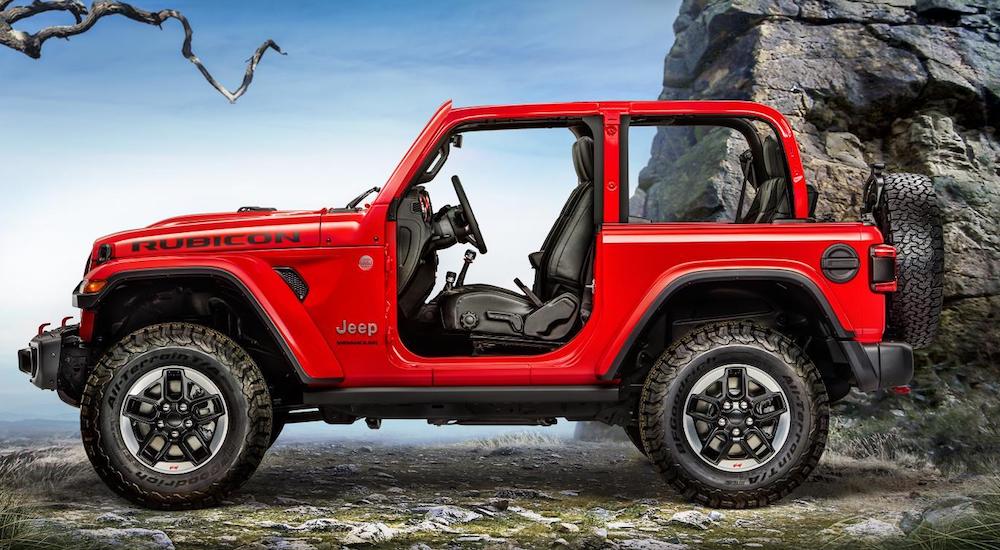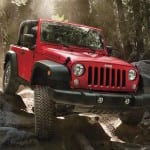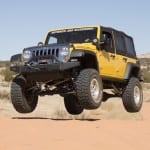It may seem like science fiction, but the next revolution of the automotive future relies on the electric motor. Electric vehicles and hybrid drivetrains are becoming more and more popular each year. More customers are turning to electric options as viable daily commuters to get them around without the hassle (and cost) of visiting the gas station each week just to fill up. Environmental benefits aside, there’s a lot to an electric drivetrain that offers people an exciting and more efficient driving experience than traditional combustion engines. While it has been easy to see the advantages of an electric engine for fuel economy some still view an electric motor as a limitation. This is no more apparent than in the world of off-road vehicles. When Jeep recently made the announcement of an electric Wrangler in the near future it certainly raised the eyebrows of those suspicious of the off road capabilities of an electric motor. Since driving off road provides many different challenges than on paved roads, vehicles meant for off roading need the right equipment to get the job done safely and effectively. Jeep has long been a well-known leader in automotive off-road design, so the question remains: is the idea of an all electric Wrangler far-fetched or does the use of an electric motor for off-road driving have some merit? Is the lineup of Jeep models and its loyal following of enthusiast ready for hybrid or electric Wranglers?
When you look to the advantages of an electric motor, you will quickly discover that Jeep is on the right track.
Instant Power
An all electric drivetrain is very different from a traditional combustion engine and transmission. Whereas a combustion engine relies on gasoline to drive pistons, which in turn drives the axle to propel the wheels, an electric motor and battery are much simpler in design. Electricity from the battery drives the motor which magnetically turns the axles. This naturally eliminates the need for fuel, but there are other hidden advantages you will not discover unless you’re behind the wheel of an electric vehicle.
The biggest advantage, particularly for off-road, is instant power. A traditional combustion engine relies on a significant amount of mechanical components to deliver the power to the wheels. This means that the amount of power the engine can pump out is not the same amount the wheels receive. Power is lost to heat, friction, and other forces along the entire drivetrain draining the vehicle of the performance needed for off-road adventures.
Electric motors are different since they rely on fewer physical moving parts. Magnetically driving the axle involves less friction and heat so more power is transferred directly to the wheels. While the electrical systems themselves are more sophisticated and complicated the physical drive motors and the process of transmitting power to the wheels is often a much more straightforward process. This added boost in performance should leave no trail in your path that cant be conquered.
An electric motor is also nearly instantaneous in its delivery of the power. Forget the days where you have to consistently rev the engine before getting to the point where the motor can power over challenging obstacles. With an electric motor, the moment you step on the pedal, the full range of torque and horsepower available can be delivered to the wheels. This makes an electric powered Jeep Wrangler more responsive, capable, and more fun on the trails or on the road.
Greater Reliability
The thing that has really makes the Jeep Wrangler stand out above other off-roading options is its history of reliability, durability, and longevity. First built as a combat vehicle for the military, the Wrangler has changed little in how much abuse it can handle without failing.
An electric Wrangler promises to be even more reliable thanks to the inherently simple design of an electric motor. With traditional combustion engines, there are hundreds, if not thousands, of moving parts that must be choreographed in sync to work properly. While driving in an off-road environment, the typical bumps and bruises a vehicle will experience can damage any number of important drivetrain components.
With an electric motor, things are different. An electric motor uses less physical parts to produce power. In fact, the motor/battery combination uses more wiring and solid connections than moving parts. This means there is less to break when the motor encounters a rough ride. Parts that you could damage tend to be easier to repair or replace as well.
In an off-road environment, durability and longevity are crucial to survival and success. Unless you have the ability to carry the right spare part if something goes wrong, a small failure or accident can leave you stranded out with no hope of rescue. When you have the reliability of an electric motor, however, the possibility of facing such a worst-case scenario drastically decreases.
The Future Of The Wrangler
For those opposed to the idea of an all electric Wrangler, rest assured the Jeep isn’t changing anything anytime soon. Recognizing they have a highly successful design, the company plans to roll out the all electric version slowly in addition to their existing gas-powered model offerings.
While it may take some time to win over those leary of an electric powered Wrangler it most definitely will be a winner, on the road or on the trails. As more and more people discover the advantages an electric motor/battery setup offers on or off the road, this new technology may quickly become a standard in automotive design. Best of all, this new technology also has more possibilities to offer in the future.
As battery technology improves, for example, you can look forward to longer and longer off-road trips without the need to fuel up. Solar charging and portable batteries will also help to extend the range of the Wrangler for the trips where there is no other fuel source insight. This will give drivers the ability to go further, deeper, and longer than ever before.
As with anything else, the choice of the perfect engine is a personal preference. To really decide if an electric Wrangler will be right for you, you’ll have to wait to get your hands on one for a test drive. Until that time, keep dreaming about a vehicle that just may revolutionize the way off-road manufacturers design their models.
Update: 5/10/2019
At the time the above article had been written, any electrification strategy pertinent to the Wrangler lineup had been painted in broad strokes at best. It was at the LA Auto Show back in 2017 that Jeep CEO Mike Manley had announced 2020 as the ETA for a plug-in variant. But details were limited, leaving little more than an open-ended promise.
And while the appreciable increase of hybrid, EV, and PHEV offerings has been consistent over recent years, 2017 seems to land in the middle of a lull. The initial rush of offerings had slowed to make way for more advanced R&D, and most automakers still had yet to reach the point where they were comfortable laying out thorough timelines or pledge how many EV offerings they planned to serve up.
For Jeep, the lack of historical interest in EV conveyed by parent company FCA (and its CEO, the late Sergio Marchionne) seemed to stifle any sort of aggressive strategy. In fact, Marchionne had gone as far as to state his belief that “electrification (was) not the answer.” But Manley’s statements conveyed a change of ideals, and optimistic enthusiasts were left to simply wait and speculate the possibility of an electric Wrangler to come.
Fast-forward to February 2019 and FCA’s $4.5 billion investment in the upgrade of Michigan production plants seems to be heralding in the change they had been so patiently waiting. Building upon the June 2018 declaration (made in Italy, at FCA’s investors conference) all Jeep products will be receiving the option of electrified powertrains. And while that statement still feels broad and ill-defined, the promise of “at least four plug-in hybrid vehicles” (separate from the RAM’s mild-hybrid eTorque system) is certainly promising.
So, what are those four plug-in hybrids?
Jeep has confirmed their intention of including the Grand Cherokee, as well as the upcoming Wagoneer and Grand Wagoneer slated for introduction in 2020. But yes, despite any shuffling of the decks, the electrified Wrangler promised back in 2017 is still on the table, and it would appear that 2020 will mark its long-awaited introduction as well. And with nearly every automaker throwing their hat in the ring (complete with long term strategies) we’d be inclined to think that FCA’s five-year electrification strategy, promise to their investors stands on the precipice of becoming a reality.
Now, the 2019 Wrangler will soon be available in its mild plug-in hybrid form, powered by a 2.0-liter I4 eTorque engine. And while that engine configuration runs an additional $1,000 over the price of the 3.6-liter V6 that comes standard, sacrificing 15 hp off o the 285 hp found in the V6, it does manage to deliver improved fuel economy.
But outside of the crunchy granola Jeepers of the greater Colorado Springs area, how many actually consider fuel economy as ranking among their primary concerns? Drivetrain? Sure. Suspension? Absolutely. Performance? Of course. But aside from mall-crawlers, most everyone is willing to sacrifice a few MPGs in exchange for the promise of greater adventure. In other words, capability is king in Wranglerville, and one can’t help but be concerned that some might have forgotten that.
Consider, for a moment, the light mockery endured by the JL upon its release. It’s not that Jeepers don’t appreciate both comfort and convenience, but the spit and polish of the JL’s design seemed a little bit of a slap-in-the-face to purists. In turn, it’s hard to ignore the potential resistance that most loyalists might levy at Jeep if they don’t get it right.
Electrification of Jeep
What works in their favor is the change in FCA’s tune regarding electrification as a whole. Opposing the dismissive past declarations of Marchionne, FCA has all but promised an electrified future for such iconic performance vehicles such as the Charger and Challenger. Of course, Mike Manley has been clear to specify that, “it isn’t going to be a V-8, supercharged, 700-horsepower engine,” but they’ll still have to cater to certain expectations of their performance-minded demographic. In other words, the electric powertrains will need to deliver the horses to the stable (up to 285 of them, at least) or few will likely opt for electric over a DI turbo.
Of course, it also needs to be designed with the intention of side-stepping criticisms of soft-roading. They’ll need to factor in expectations regarding torque and tow ratings, as well. And the fact that the EV Wrangler will need to be designed in a manner that allows a high-voltage electrical system to be (at least) half submerged underwater poses a number of interesting nuances demanding consideration. That last concern, of course, will be answered by Jeep’s decision to install the Power Electronic module (which includes the onboard charger and DC/DC converter) inside of a protective structure placed between the exhaust and drive shaft. So, you can rest assured that accidental electrocution going through a puddle is unlikely. The other concerns, however, are still in play so it’s clear that there are a lot of moving parts in this ambitious electrification strategy and we haven’t even gotten to a discussion of range yet.
As asked by one journalist back when the news first broke, “where does one recharge high-voltage, high-capacity batteries in the middle of the wilderness?” Don’t laugh. It’s a legitimate concern for the most adventurous of off-roaders.
But (if all of these points are being factored in by Jeep) consider the possibility of four small electric motors, independent from one another and each powering a single wheel. As far as four-wheel drive capability goes, that scenario represents an almost ideal realization of why an EV Wrangler could provide unparalleled performance.
At the end of the day, it stands to reason that economies associated with electrification (on both ends) will only continue to improve over time. And with such continual improvements being made in order to match expectations of performance associated with combustion-based powertrains (especially by FCA) we’re not quite as skeptical of EV potential as we used to be.
Our only real concern comes in the form of all-electric range. Even if those numbers continue to improve with each new EV offering, there’s a certain lack of assurance for long-distance excursionists, off-roaders, and overlanders. That said, it’s highly likely that large strides will be needed in order for FCA to gain the wider buy-in of Jeepers everywhere.
At the end of the day, we can all but expect to witness the reveal of this exciting new offering within the next nine months or so — with performance ratings likely to follow just after. Knowing all-too-well how important their target consumer base is, we doubt that Jeep will deliver a sub-par offering. Of course, it might be better designed for mall-crawlers than rock-crawlers.
Call us cynical, but that’s just how we see it.





